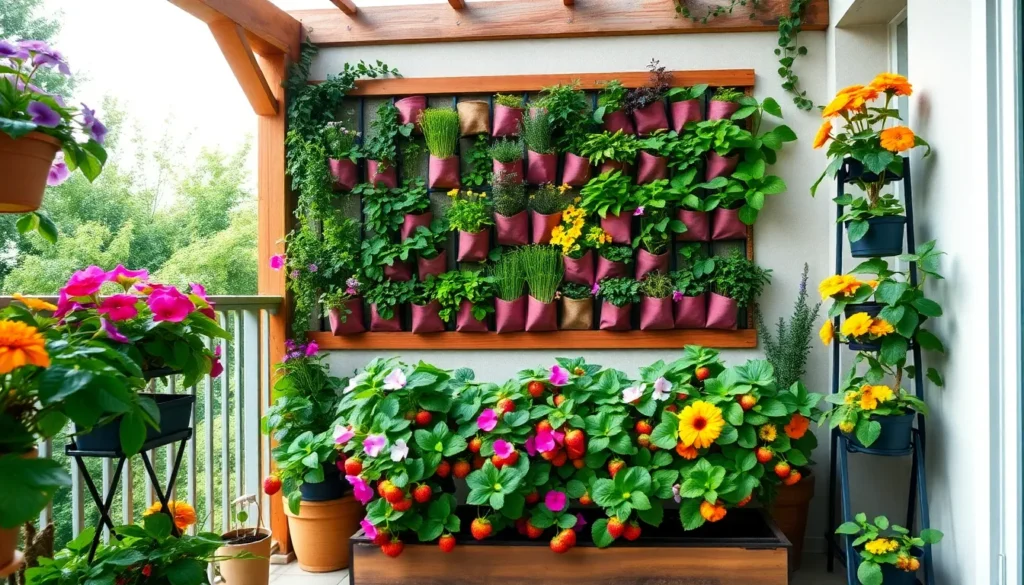Welcome to the enchanting world of balcony gardening, where even the smallest outdoor space can become a lush, vibrant oasis. Whether you’re just starting out or have a seasoned green thumb, cultivating plants on your apartment balcony offers a unique blend of tranquility and accomplishment. Our guide to the “10 Best Plants for Apartment Balconies” is designed to transform your outdoor nook into a thriving mini-garden, packed with beauty and life.
Within these pages, you’ll discover a carefully curated selection of plants that thrive in balcony environments, regardless of your level of expertise. From improving air quality to creating a serene retreat, these plants offer practical benefits that extend beyond aesthetics. With our expert tips and plant recommendations, you’ll feel confident in your ability to nurture and enjoy a flourishing garden, all while relishing the simple joy of watching your plants grow and thrive.
Lavender (Compact Aromatic Blooms)
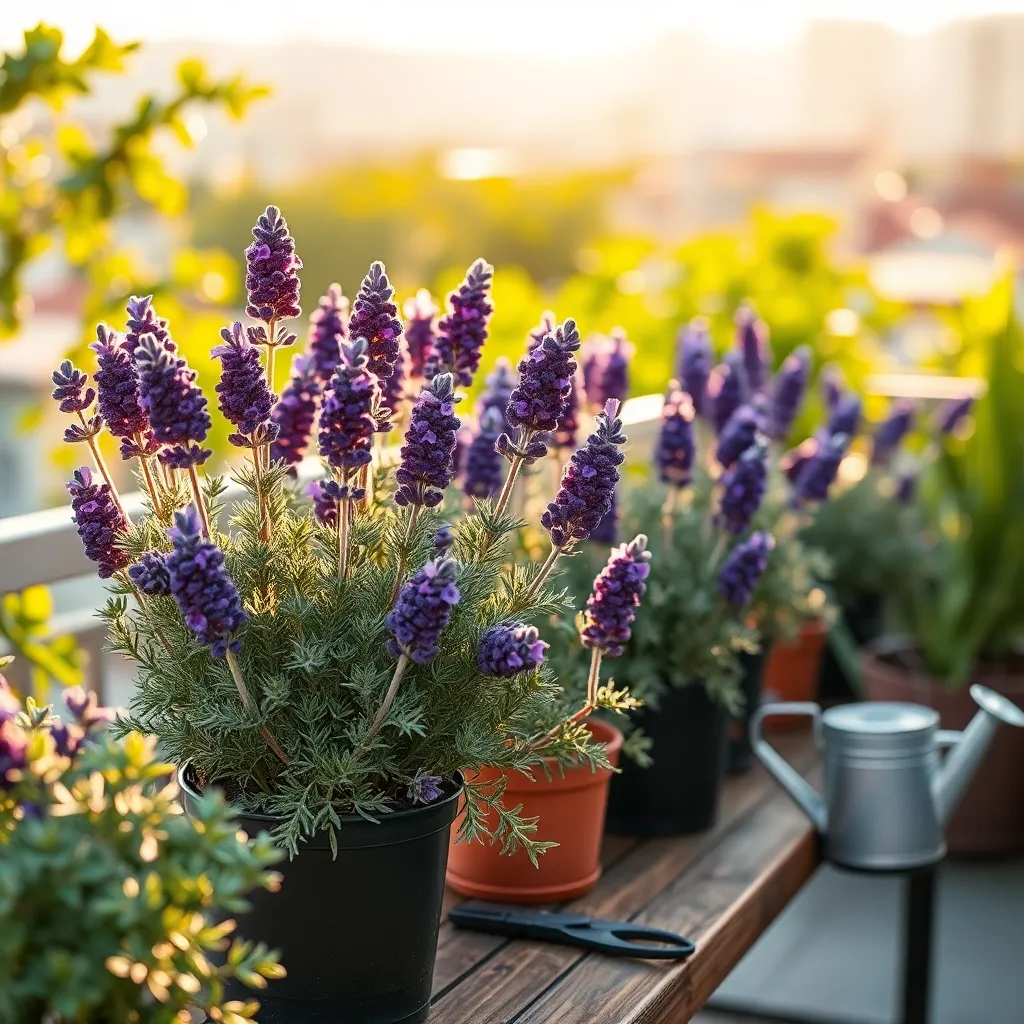
Lavender is a fantastic choice for apartment balconies due to its compact size and delightful fragrance. This hardy plant thrives in containers and can bring a touch of the Mediterranean to your urban oasis.
To get the best results, plant lavender in a container with well-draining soil, such as a mix of potting soil and sand or perlite. Ensure the container has ample drainage holes to prevent root rot, which lavender is particularly susceptible to.
Place your lavender in a spot where it will receive full sun for at least six hours a day. If you’re in a region with particularly intense sunlight, consider providing light afternoon shade to prevent leaf scorch.
Watering should be done sparingly, as lavender prefers to dry out between waterings. During the growing season, water when the top inch of soil feels dry, and reduce watering in the winter months.
Cherry Tomatoes (Vertical Growth for Small Spaces)
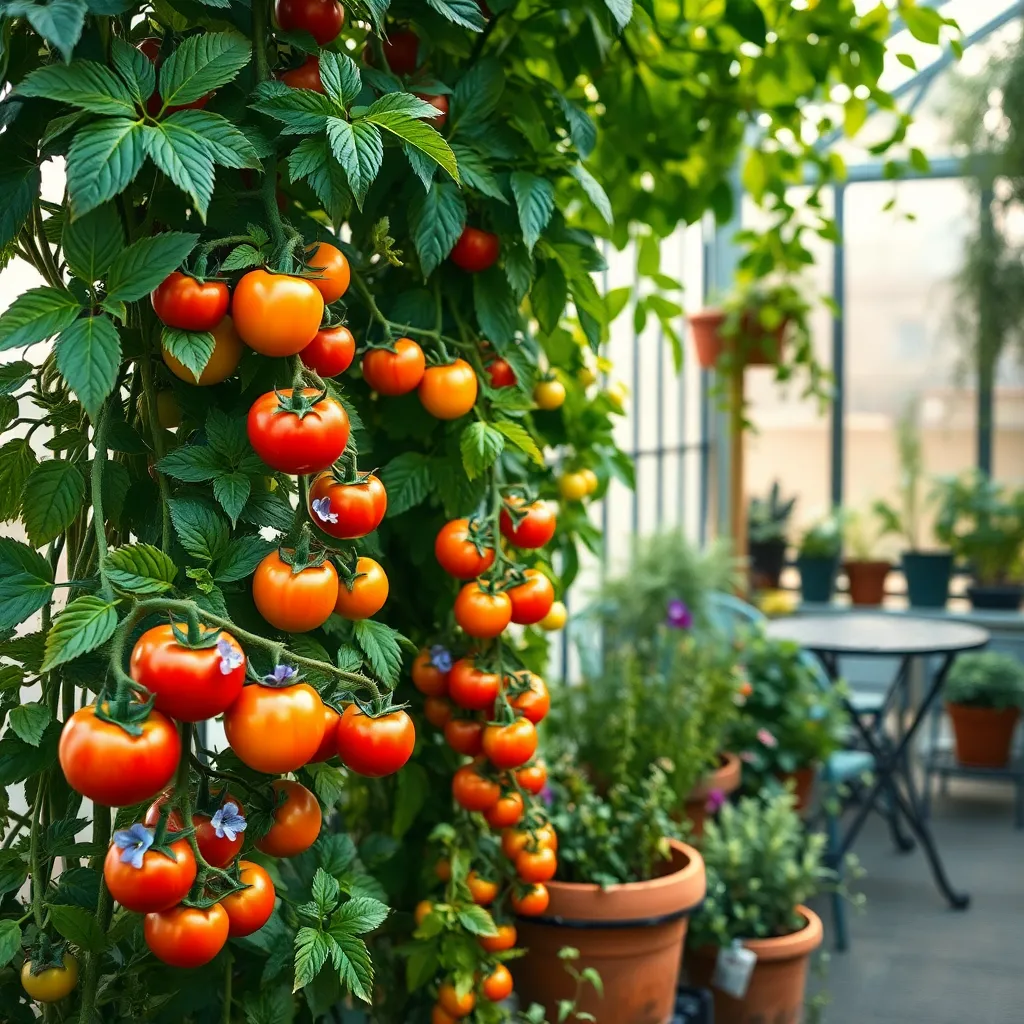
Cherry tomatoes are an excellent choice for apartment balconies due to their ability to grow vertically. Their compact size and need for minimal space make them perfect for urban gardeners looking to maximize their small areas.
To start growing cherry tomatoes, choose a pot that is at least 12 inches deep and wide, filled with a high-quality potting mix. Ensure the pot has drainage holes to prevent waterlogging, which can lead to root rot.
Providing support is crucial for vertical growth, so use a trellis or sturdy stake to encourage upward expansion. This not only saves space but also helps in better air circulation and sun exposure, leading to healthier plants.
Water your cherry tomatoes consistently, keeping the soil moist but not soggy. Fertilize them every two weeks with a balanced, water-soluble fertilizer to promote bountiful fruiting.
For those looking to enhance their gardening skills, consider pruning your tomato plants to remove suckers. This advanced technique helps direct energy into fruit production, resulting in a more abundant harvest.
Succulent Varieties (Low-Maintenance and Drought-Tolerant)
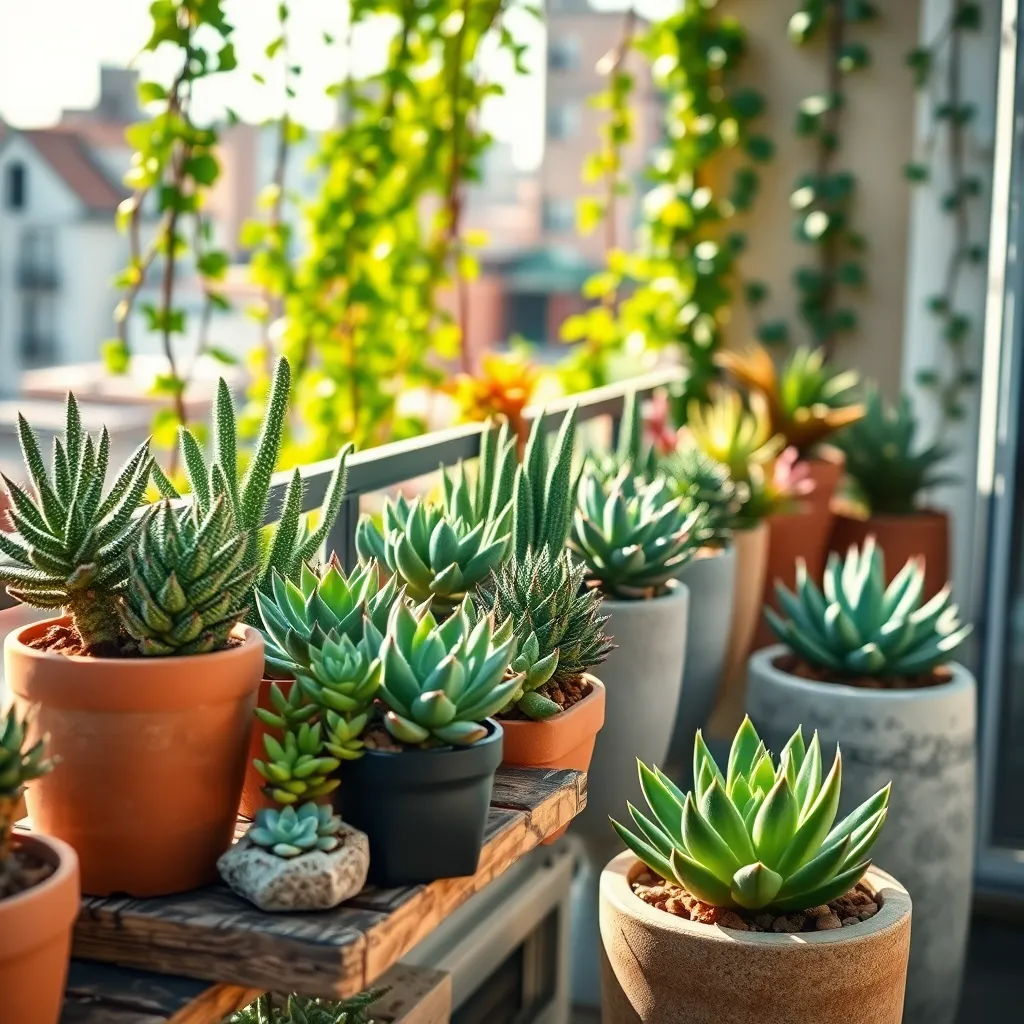
Succulents are an ideal choice for apartment balconies due to their low-maintenance and drought-tolerant nature. These plants thrive in containers and require minimal watering, making them perfect for busy urban gardeners.
When selecting soil for succulents, opt for a well-draining mix to prevent root rot. A blend of potting soil, sand, and perlite will create the perfect environment for healthy growth.
Water your succulents sparingly, typically once every two weeks, allowing the soil to dry out completely between waterings. During the winter months, reduce watering even further as the plants enter a dormant phase.
Place your succulents in a spot where they can receive bright, indirect sunlight for optimal growth. If direct sunlight is limited, consider using a grow light to supplement their light needs.
For those looking to expand their collection, propagating succulents is an easy and rewarding process. Simply cut a healthy leaf, allow it to dry for a few days, and then plant it in soil to root.
Succulents like the Jade Plant, Aloe Vera, and Echeveria are excellent choices for both beginners and experienced gardeners. Their varied forms and colors can add a touch of nature’s artistry to your balcony space.
Herb Baskets (Space-Saving Culinary Delights)
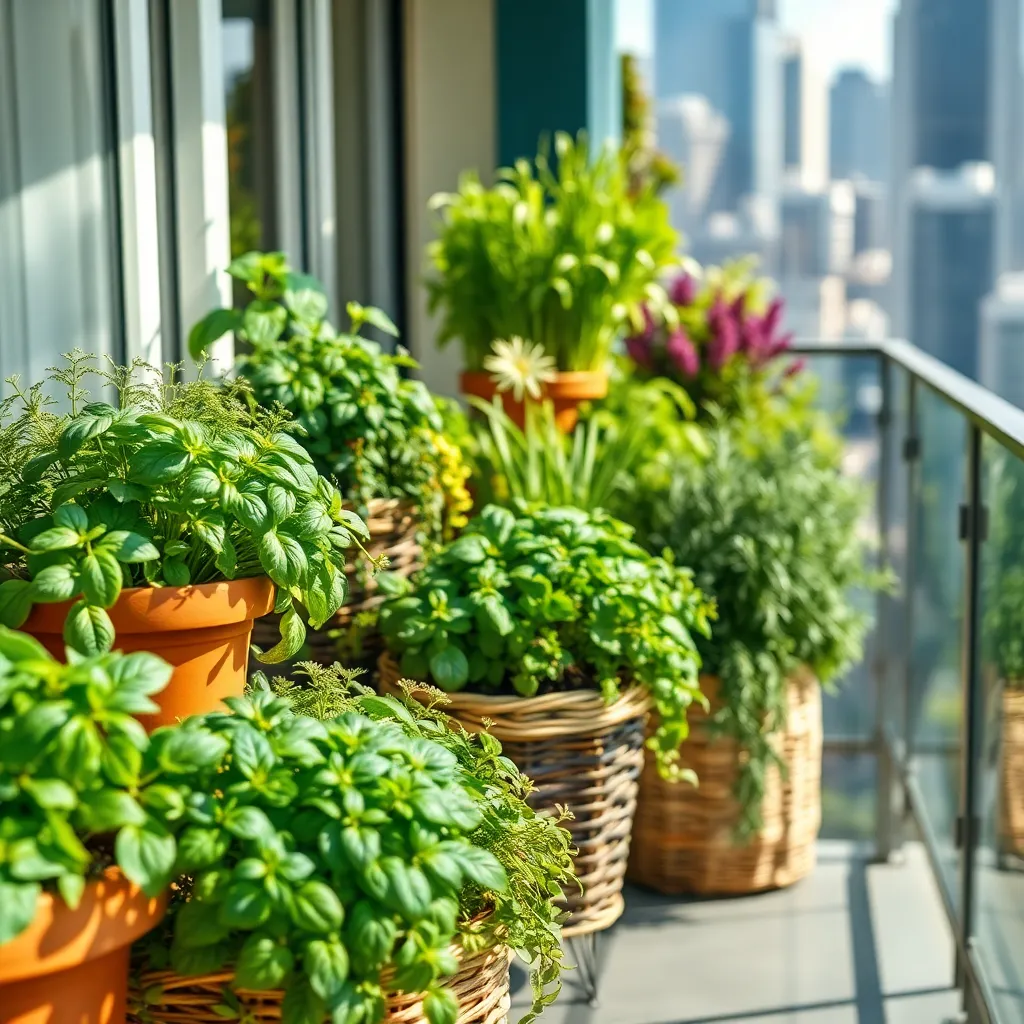
Herb baskets are a fantastic way to maximize your apartment balcony’s space while adding fresh flavors to your cooking. By selecting a mix of herbs such as basil, thyme, and rosemary, you can create a lush and aromatic mini-garden that thrives in small spaces.
Choose a container with good drainage, such as a hanging basket or a window box, to prevent waterlogged soil. Use a high-quality potting mix that retains moisture yet drains well, and amend it with compost to provide nutrients.
Place your herb basket in a spot that receives at least six hours of sunlight each day, as most culinary herbs thrive in full sun. Water your herbs regularly, ensuring the soil stays moist but not soggy, and consider using a drip irrigation system for consistent watering.
For beginners, start with easy-to-grow herbs like parsley and cilantro, which can be harvested frequently to encourage new growth. Advanced gardeners can experiment with companion planting, pairing herbs that support each other’s growth, such as basil and tomato, to enhance both flavor and yield.
Dwarf Citrus Trees (Fragrant Fruits in Limited Space)
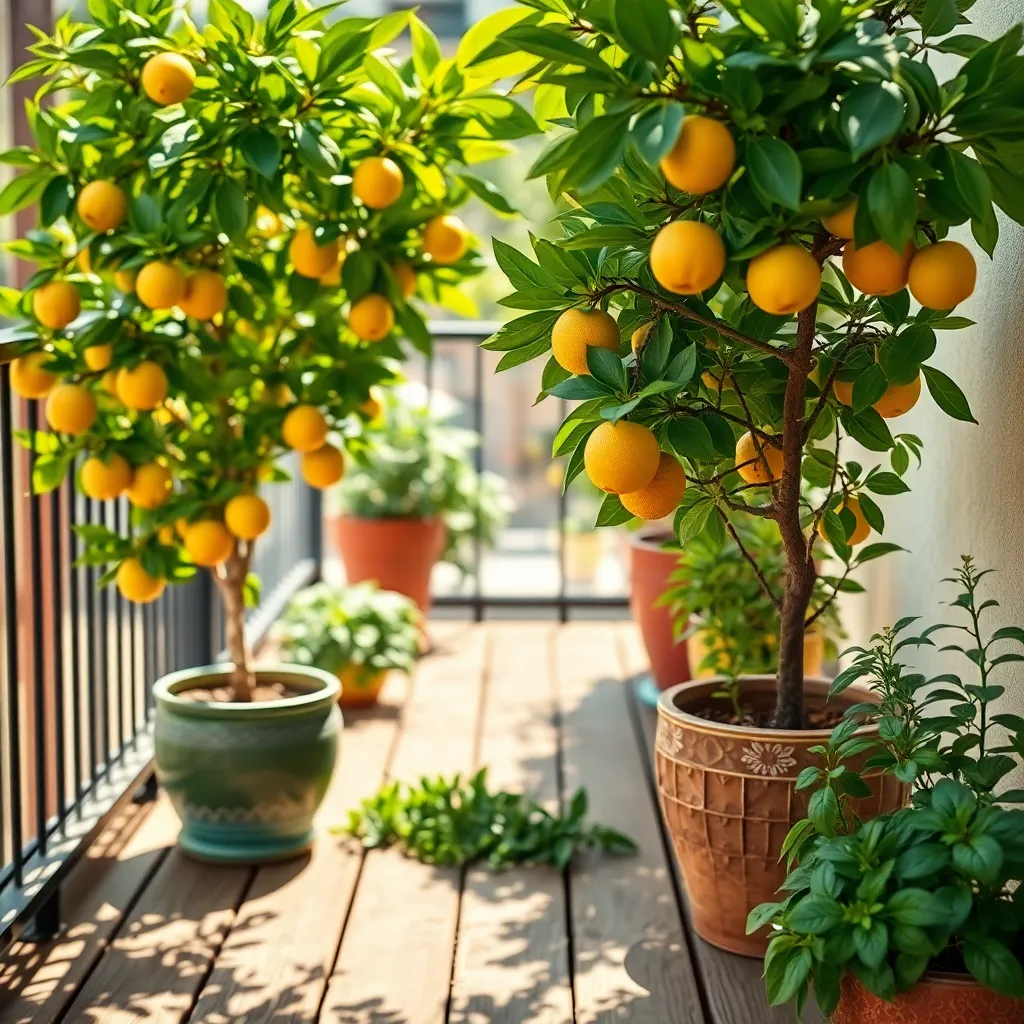
Dwarf citrus trees are an excellent choice for anyone looking to add a touch of fragrance and flavor to their apartment balcony. These compact trees, such as the Meyer lemon or Calamondin orange, thrive in containers and can produce fruit year-round with the right care.
To get started, select a pot that is at least 18 inches in diameter with good drainage holes. Use a well-draining potting mix specifically designed for citrus or succulents to ensure your tree’s roots remain healthy and free from rot.
Place your citrus tree in a spot where it will receive at least six to eight hours of sunlight daily, as they require full sun for optimal growth and fruit production. If natural light is insufficient, consider supplementing with a grow light to maintain vigorous growth.
Water your dwarf citrus tree deeply whenever the top inch of soil feels dry to the touch, typically every 5-7 days, depending on your climate and the season. During the growing season, feed your plant with a balanced, slow-release fertilizer formulated for citrus, following the package instructions.
For those with a bit more experience, consider pruning your tree in early spring to shape it and encourage new growth. Keep an eye out for common pests such as aphids or spider mites, and treat any infestations promptly with insecticidal soap or neem oil.
Climbing Ivy (Natural Privacy Screen)

Climbing ivy is an excellent choice for apartment balconies, offering a natural privacy screen that’s both attractive and functional. This hardy plant thrives in a variety of conditions, making it suitable for beginner gardeners looking to enhance their outdoor space.
To grow climbing ivy successfully, ensure it has a sturdy support structure like a trellis or railing to climb. Place your ivy in a spot with indirect sunlight for optimal growth, as too much direct sun can scorch the leaves.
Water your ivy consistently, but avoid over-watering, which can lead to root rot. A good rule of thumb is to let the top inch of soil dry out between waterings, ensuring the plant receives enough moisture without being waterlogged.
For those with more gardening experience, consider experimenting with different varieties of ivy, such as English ivy or Boston ivy, to add diverse textures and colors. Regular pruning will keep your ivy looking lush and prevent it from becoming unruly, ensuring it remains a beautiful feature on your balcony.
Petunia Planters (Vibrant and Cascading Color)
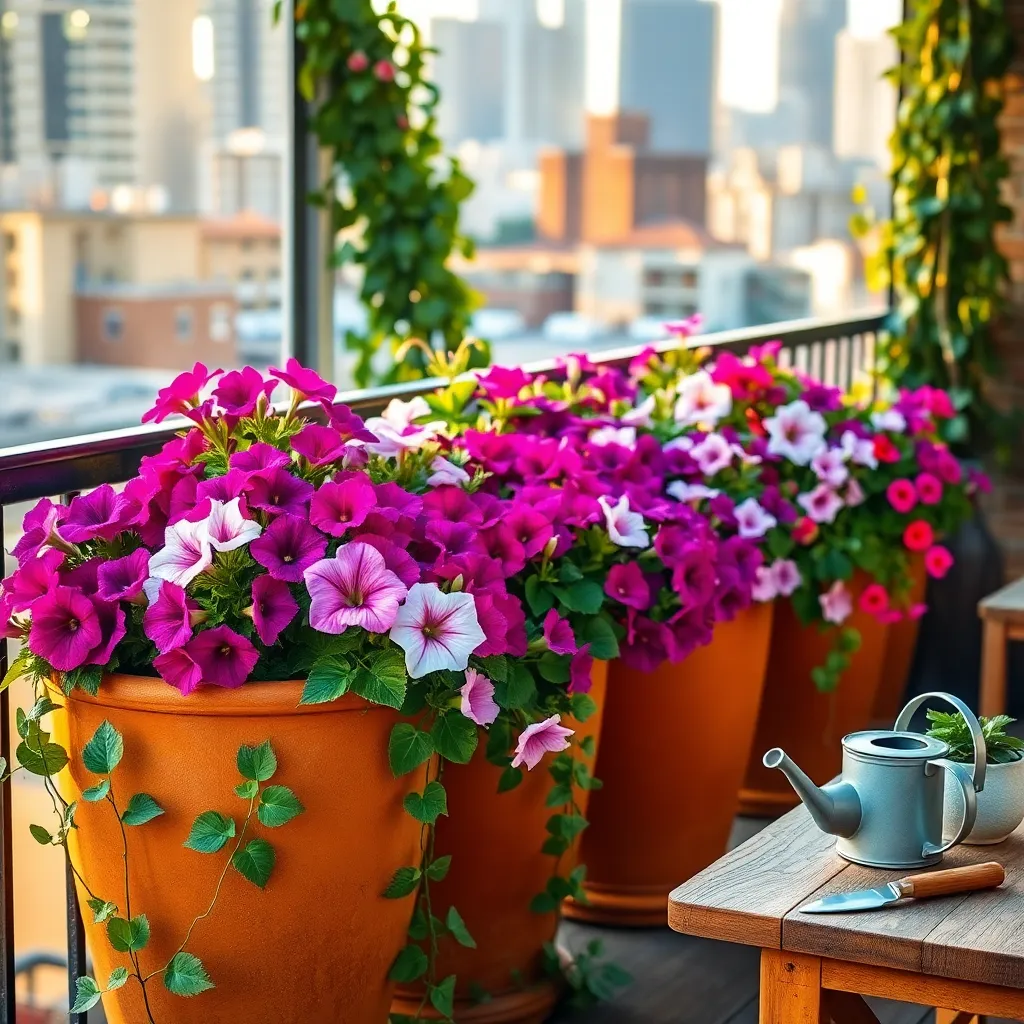
Petunia planters offer a vibrant and cascading display of color that can transform any apartment balcony into a lively garden retreat. These versatile flowers are perfect for both hanging baskets and container gardens, providing a stunning visual impact with their abundant blooms.
Begin with selecting a container that has good drainage to prevent root rot, as petunias thrive in well-draining soil. Use a potting mix enriched with organic matter to provide the necessary nutrients that will support lush growth throughout the season.
Position your petunia planters in a location where they receive at least six hours of sunlight daily, as this is vital for their blooming potential. Water consistently but avoid overwatering; aim to keep the soil moist but not soggy, especially during the hotter months.
To encourage continuous blooming, deadhead spent flowers regularly and consider feeding your petunias with a balanced liquid fertilizer every two weeks. For those looking for a more advanced approach, experiment with different varieties such as ‘Wave’ petunias, known for their exceptional spreading habit.
Bamboo Screens (Wind-Resistant and Elegant)
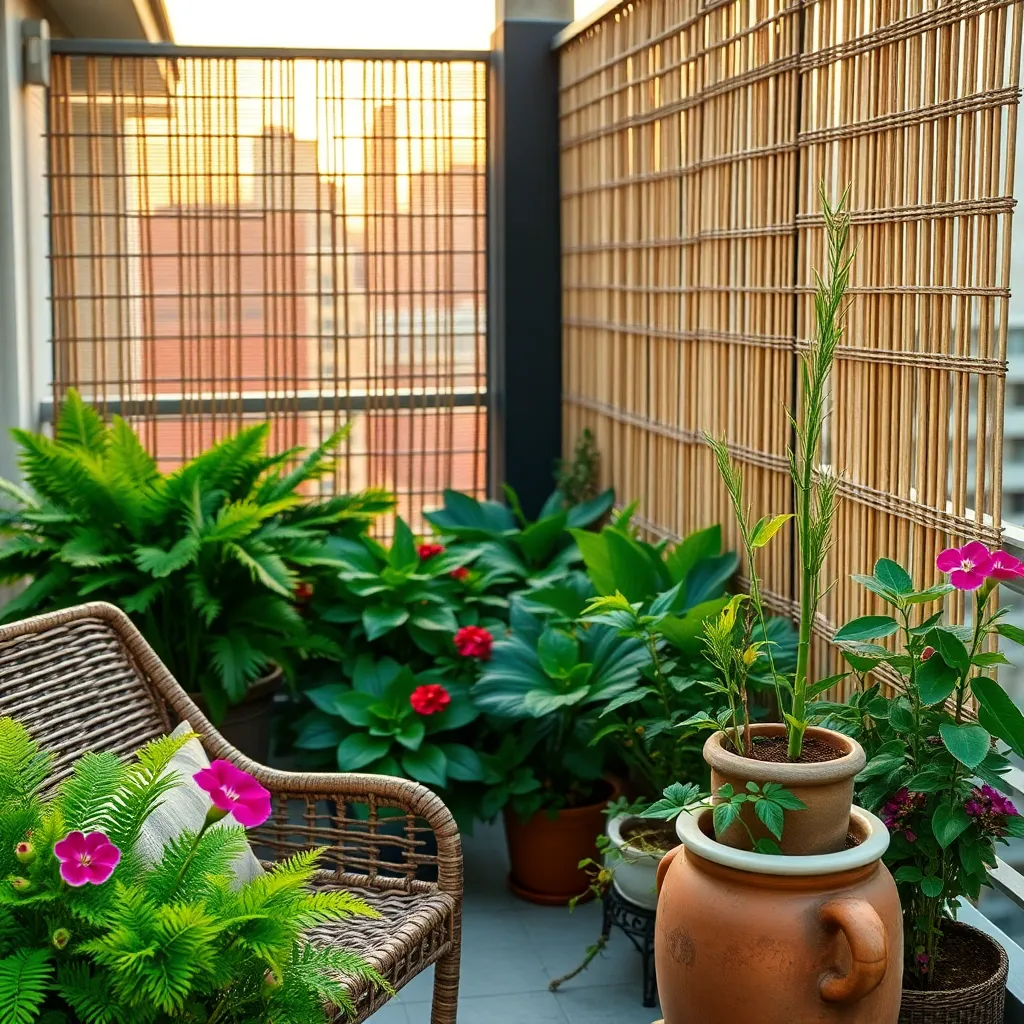
Bamboo, with its natural elegance and resilience, is an excellent choice for creating a wind-resistant screen on your apartment balcony. This plant not only provides privacy but also thrives in various climates, making it a versatile addition to urban spaces.
When growing bamboo on a balcony, it’s crucial to select the right variety, such as clumping bamboo, which is more manageable in containers. Ensure your container has good drainage, and use a high-quality potting mix enriched with organic matter for optimal growth.
Water your bamboo regularly, especially during dry spells, to keep the soil consistently moist yet not waterlogged. A layer of mulch can help retain moisture and maintain a stable root temperature, promoting healthy growth.
For those with more experience, consider using slow-release fertilizer once or twice a year to encourage lush foliage. Regularly check for pests like aphids and use an appropriate natural remedy if needed, ensuring your bamboo remains healthy and vibrant.
Fuchsia Hanging Baskets (Eye-Catching Color for Shade)
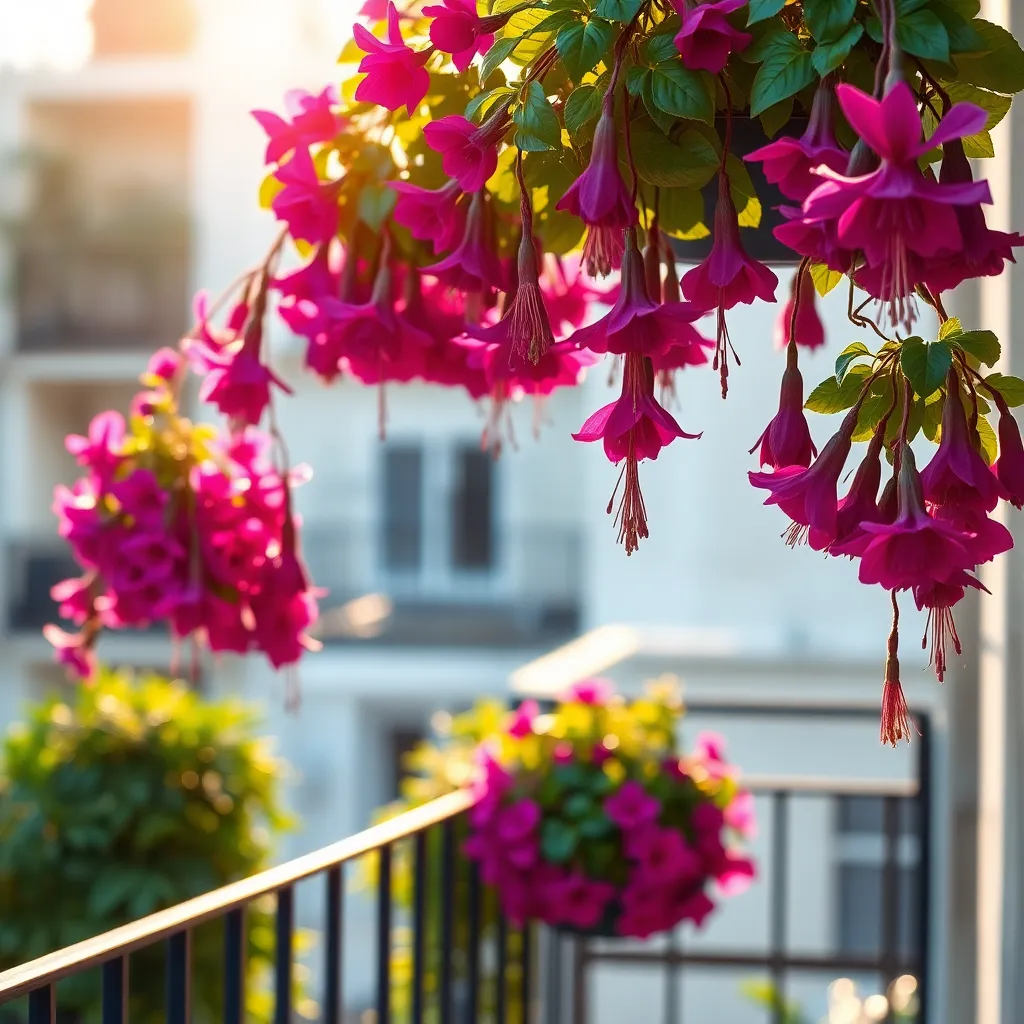
Fuchsia hanging baskets are perfect for adding a splash of color to shaded apartment balconies. Known for their vibrant, drooping flowers, fuchsias thrive in partial to full shade, making them a top choice for shaded areas.
To ensure your fuchsia basket flourishes, choose a well-draining potting mix rich in organic matter. Regular watering is crucial, as fuchsias prefer consistently moist soil, but be cautious to avoid waterlogging, which can harm the roots.
For beginners, it’s beneficial to start with a hardy variety such as ‘Dollar Princess’ or ‘Swingtime’, known for their resilience and prolific blooming. More experienced gardeners can experiment with trailing varieties, which create a cascading effect over the basket’s edges, enhancing visual appeal.
Feeding your fuchsias with a balanced liquid fertilizer every two weeks during the growing season will promote lush growth and copious blooms. Additionally, deadheading spent flowers encourages continuous flowering, ensuring your balcony remains vibrant throughout the season.
Mint Varieties (Pest-Repelling and Refreshing Aroma)
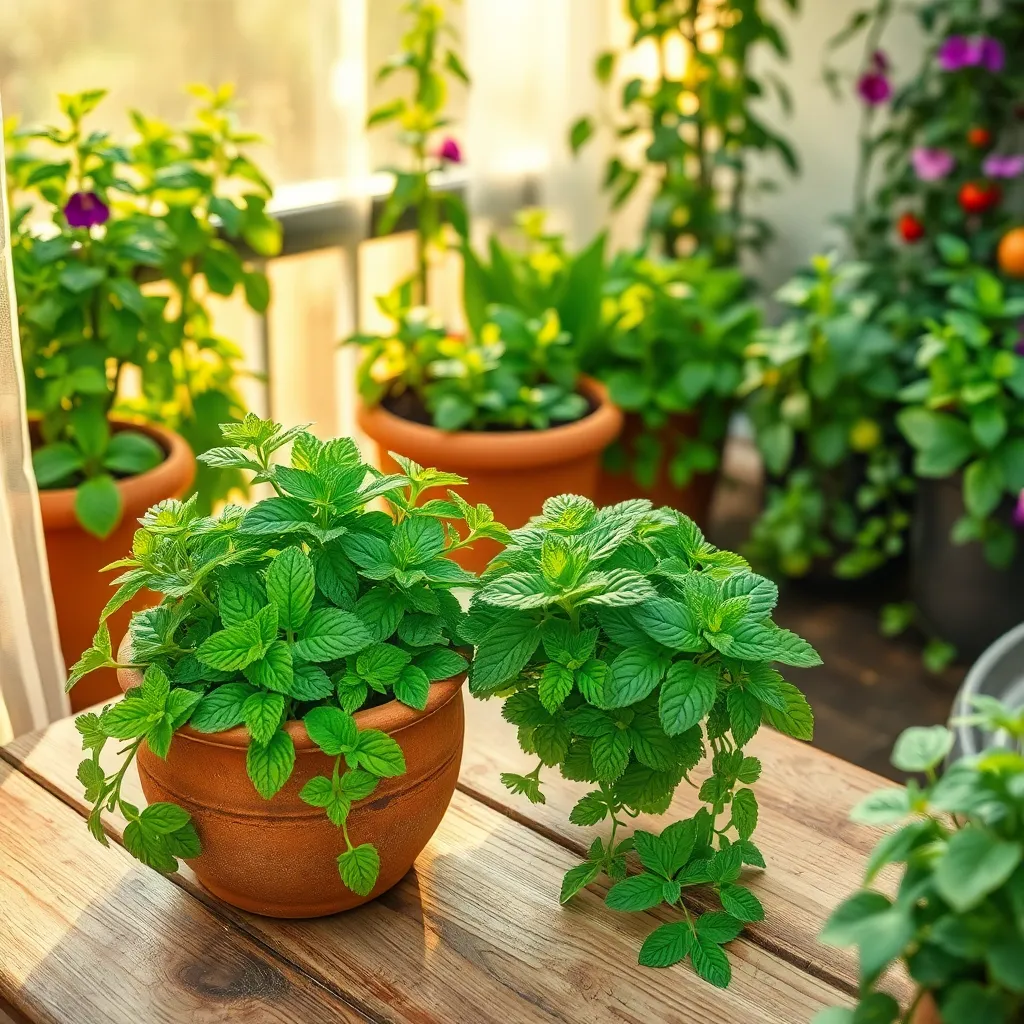
Mint varieties are a fantastic choice for apartment balconies, offering both a refreshing aroma and natural pest-repelling qualities. Varieties like peppermint, spearmint, and apple mint are not only easy to grow but also thrive in containers, making them perfect for small spaces.
When growing mint, use a pot with good drainage and fill it with a lightweight potting mix rich in organic matter. Be sure to water your mint regularly, keeping the soil consistently moist, but avoid overwatering as mint does not like to sit in waterlogged soil.
Mint thrives in partial to full sun, so place your pot where it can receive at least 4 to 6 hours of sunlight daily. For those living in hotter climates, providing some afternoon shade can help prevent the leaves from scorching and ensure a lush, healthy plant.
Advanced gardeners can experiment with companion planting, using mint to deter pests from other balcony plants like tomatoes and peppers. Additionally, consider harvesting mint leaves regularly to encourage bushier growth and prevent the plant from becoming leggy or invasive.
Conclusion: Growing Success with These Plants
In exploring the ’10 Best Plants for Apartment Balconies,’ we’ve uncovered key relationship concepts that mirror the nurturing of greenery: patience, attentiveness, adaptability, communication, respect for boundaries, mutual growth, resilience, emotional support, shared responsibilities, and celebrating small victories. Just as each plant requires unique care, every relationship flourishes through understanding and dedicated effort.
As a tangible next step, why not choose one “relationship plant” from our list and begin your balcony garden today? This small act of cultivation can serve as a daily visual reminder of the nurturing required in relationships.
Don’t let this valuable information slip away. Bookmark this article now, so you can revisit it whenever you need a refreshing perspective on nurturing your personal bonds.
Remember, just like a well-tended balcony garden, your relationships can thrive with consistent care and attention. As you embark on this journey, envision a future where your relationships are as vibrant and resilient as the plants you nurture. Together, let’s cultivate connections that stand the test of time. Save this guide as a trusted companion on your path to relationship success.

